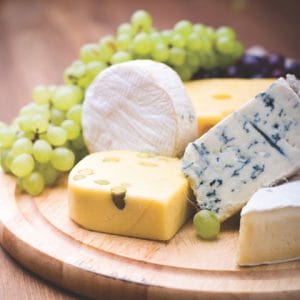 Cultivating a deep appreciation for wine and cheese together takes time. Just as wine and cheese need time to develop, we must also take time to purposefully appreciate this 4,000 year marriage. I propose that you approach pairing wine with cheese by thinking about the components and character of each, and by concentrating on a single wine and a single cheese over time. Luckily, we’re in fertile ground for this: The Northwest is in the midst of a rebirth and explosion of artisanal cheese and wine.
Cultivating a deep appreciation for wine and cheese together takes time. Just as wine and cheese need time to develop, we must also take time to purposefully appreciate this 4,000 year marriage. I propose that you approach pairing wine with cheese by thinking about the components and character of each, and by concentrating on a single wine and a single cheese over time. Luckily, we’re in fertile ground for this: The Northwest is in the midst of a rebirth and explosion of artisanal cheese and wine.
Why Pair Wine and Cheese?
We take the marriage of wine and cheese for granted. But why? Because cheese can make mediocre wines taste downright delicious!
On one level, they each soften the excesses of the other. The acidity and tannins in wine will often balance the richness of cheese and vice versa. This sets the stage for the greatest aspect of this combination: the synergy that results from complementary and contrasting flavors.
Perhaps there’s something to the historical development of wine and cheese as foods that yield such wonderful matches. After all, as products of fermentation, they both arose out of a need to combat spoilage and thus allow for longer storage. The greatest examples of wine and cheese are intimately tied to specific places that evolved through decades or even centuries of trial and error, such as Napa Valley or Prosser, Wa. Not surprisingly, people describe both wine and cheese in the same nomenclature—fruity, acidic, robust—and enthusiasts engage in elaborate tasting rituals to appreciate their flavors.
Making the Pairing Work
Finding successful wine and food matches is empirical— you won’t know what works until you actually try them together. Those handy cheese and wine cards can be useful to narrow wines down, but in the end you really learn only by tasting. When our team tastes a new cheese, we think of four things in the following order: texture, components, flavor and character.
These are the ways that most sommeliers go about matching wine with food. But I would add another: match the character of the cheese to the wine. Specifically, if you’re serving an artisan cheese—made from local milk by a single person or small team and aged in a local area—try to find an artisanal wine, one for which the producer grows the grapes himself, makes the wine, and ages it at the estate. Similarly, if you’re serving a cheese made from raw milk sourced from pastured animals, try to find a wine with a similar pedigree, such as one made from grapes sourced from a single vineyard. Not only are these pairings poetic, they are usually quite congenial.
The single greatest thing you can do to enhance your appreciation of wine and cheese is to visit a vineyard or a dairy.
Making the Pairing Mature
As living things, both wine and cheese develop over time. One of the most rewarding ways to enjoy them together is to taste that development. Find a cheese and a wine that you like and stick with it for a while. Buy a wheel and taste how it changes over the weeks.
Cultivating an appreciation of wine and cheese together never ends. Taste with a sense of purpose, connect the people and places with the food they produce, and you’ll live better.
Leah Grout